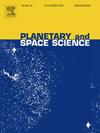The thermal impact of the self-heating effect on airless bodies. The case of Mercury’s north polar craters
IF 1.7
4区 物理与天体物理
Q3 ASTRONOMY & ASTROPHYSICS
引用次数: 0
Abstract
Thermal models are essential for studying airless planetary surfaces, as the interaction between topography and thermophysical properties plays a crucial role in determining a surface’s response to localized illumination. Accurate temperature distribution calculations require a comprehensive investigation of sunlight scattering, a process that, despite its computational challenges, cannot be overlooked, especially when high resolution is necessary. Furthermore, thermal analysis is fundamental for assessing the stability of volatiles in polar regions. In this study, we introduce a novel approach by discretizing the Sun into 100 individual elements, allowing for a highly precise simulation of solar flux—an innovation crucial for accurately capturing temperature distributions in Mercury’s polar craters, given the planet’s proximity to the Sun. This level of discretization significantly enhances the accuracy of the thermal model, ensuring a more realistic depiction of how sunlight interacts with crater topography. We developed a dual-model approach that simulates both direct solar illumination and its scattering on two craters, Laxness and Fuller, located at Mercury’s north pole. The illumination and thermal model predict temperature distribution and heat transfer based on the material’s thermal properties and topography. The study examines the interaction between direct sunlight, causing localized heating, and scattered light, which influences the thermal response of surface materials. Detailed illumination maps and temperature profiles were generated over two Hermean years, revealing the significant impact of the self-heating effect on temperature distribution. The results show that specific regions experience indirect solar flux due to the craters’ morphology, particularly in permanently shadowed regions (PSRs) that are heated exclusively by scattered radiation. Maximum temperature profiles for the Laxness and Fuller craters show a substantial temperature increase within PSRs compared to areas exposed to direct illumination. However, while self-heating does not affect the stability of water ice in the Laxness crater, in the Fuller crater, a section within the radar-bright material reaches temperatures of up to 210 K, potentially threatening the stability of water ice. Further investigation with the onboard SIMBIO-SYS instrument on the BepiColombo mission will help to better understand the current state of these craters and their volatile deposits.
自热效应对无空气天体的热影响。水星北极陨石坑的情况
热模型对于研究无空气行星表面至关重要,因为地形和热物理性质之间的相互作用在决定表面对局部光照的响应方面起着至关重要的作用。精确的温度分布计算需要对太阳光散射进行全面研究,尽管这一过程在计算上具有挑战性,但不容忽视,尤其是在需要高分辨率的情况下。此外,热分析也是评估极地地区挥发物稳定性的基础。在这项研究中,我们引入了一种新方法,将太阳离散为 100 个单独的元素,从而能够高度精确地模拟太阳通量--鉴于水星靠近太阳,这种创新对于准确捕捉水星极地环形山的温度分布至关重要。这种离散化程度大大提高了热模型的准确性,确保更真实地描述阳光与陨石坑地形的相互作用。我们开发了一种双模型方法,模拟太阳直射及其对位于水星北极的拉克斯内斯和富勒这两个陨石坑的散射。照明和热模型根据材料的热特性和地形预测温度分布和热传导。这项研究考察了造成局部加热的直射阳光与影响表面材料热反应的散射光之间的相互作用。研究人员绘制了两个赫曼年的详细光照图和温度分布图,揭示了自加热效应对温度分布的重要影响。结果表明,由于陨石坑的形态,特定区域会受到间接太阳光通量的影响,特别是在完全由散射辐射加热的永久阴影区(PSRs)。拉克斯内斯陨石坑和富勒陨石坑的最高温度曲线显示,与受到直接照射的区域相比,PSRs 内的温度大幅上升。然而,虽然自热并不影响拉克斯内斯陨石坑中水冰的稳定性,但在富勒陨石坑中,雷达照射物质内的一段温度高达 210 K,有可能威胁到水冰的稳定性。利用贝皮科伦坡飞行任务上的星载 SIMBIO-SYS 仪器进行进一步调查,将有助于更好地了解这些陨石坑及其挥发性沉积物的现状。
本文章由计算机程序翻译,如有差异,请以英文原文为准。
求助全文
约1分钟内获得全文
求助全文
来源期刊

Planetary and Space Science
地学天文-天文与天体物理
CiteScore
5.40
自引率
4.20%
发文量
126
审稿时长
15 weeks
期刊介绍:
Planetary and Space Science publishes original articles as well as short communications (letters). Ground-based and space-borne instrumentation and laboratory simulation of solar system processes are included. The following fields of planetary and solar system research are covered:
• Celestial mechanics, including dynamical evolution of the solar system, gravitational captures and resonances, relativistic effects, tracking and dynamics
• Cosmochemistry and origin, including all aspects of the formation and initial physical and chemical evolution of the solar system
• Terrestrial planets and satellites, including the physics of the interiors, geology and morphology of the surfaces, tectonics, mineralogy and dating
• Outer planets and satellites, including formation and evolution, remote sensing at all wavelengths and in situ measurements
• Planetary atmospheres, including formation and evolution, circulation and meteorology, boundary layers, remote sensing and laboratory simulation
• Planetary magnetospheres and ionospheres, including origin of magnetic fields, magnetospheric plasma and radiation belts, and their interaction with the sun, the solar wind and satellites
• Small bodies, dust and rings, including asteroids, comets and zodiacal light and their interaction with the solar radiation and the solar wind
• Exobiology, including origin of life, detection of planetary ecosystems and pre-biological phenomena in the solar system and laboratory simulations
• Extrasolar systems, including the detection and/or the detectability of exoplanets and planetary systems, their formation and evolution, the physical and chemical properties of the exoplanets
• History of planetary and space research
 求助内容:
求助内容: 应助结果提醒方式:
应助结果提醒方式:


